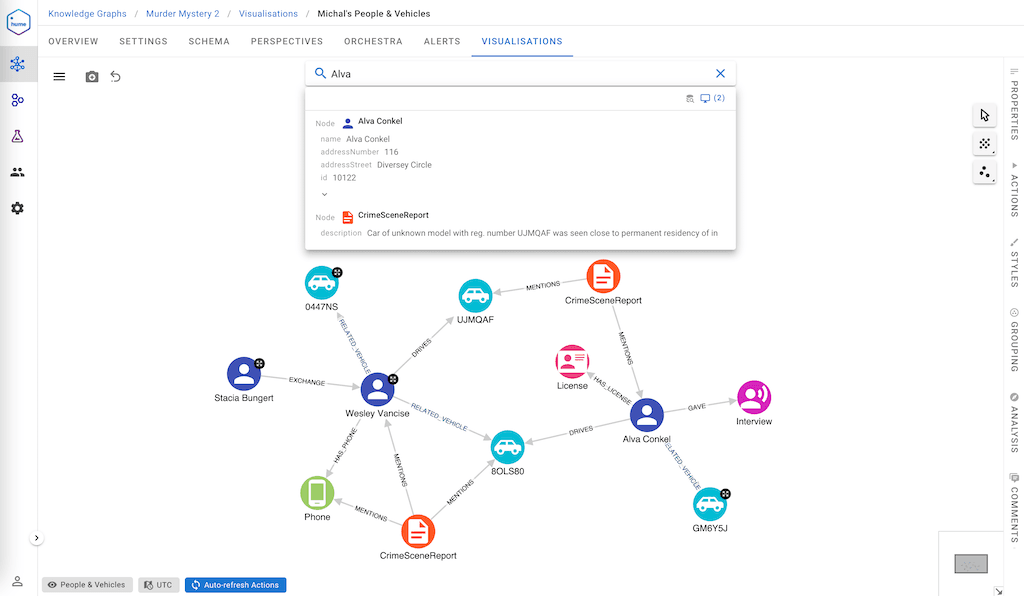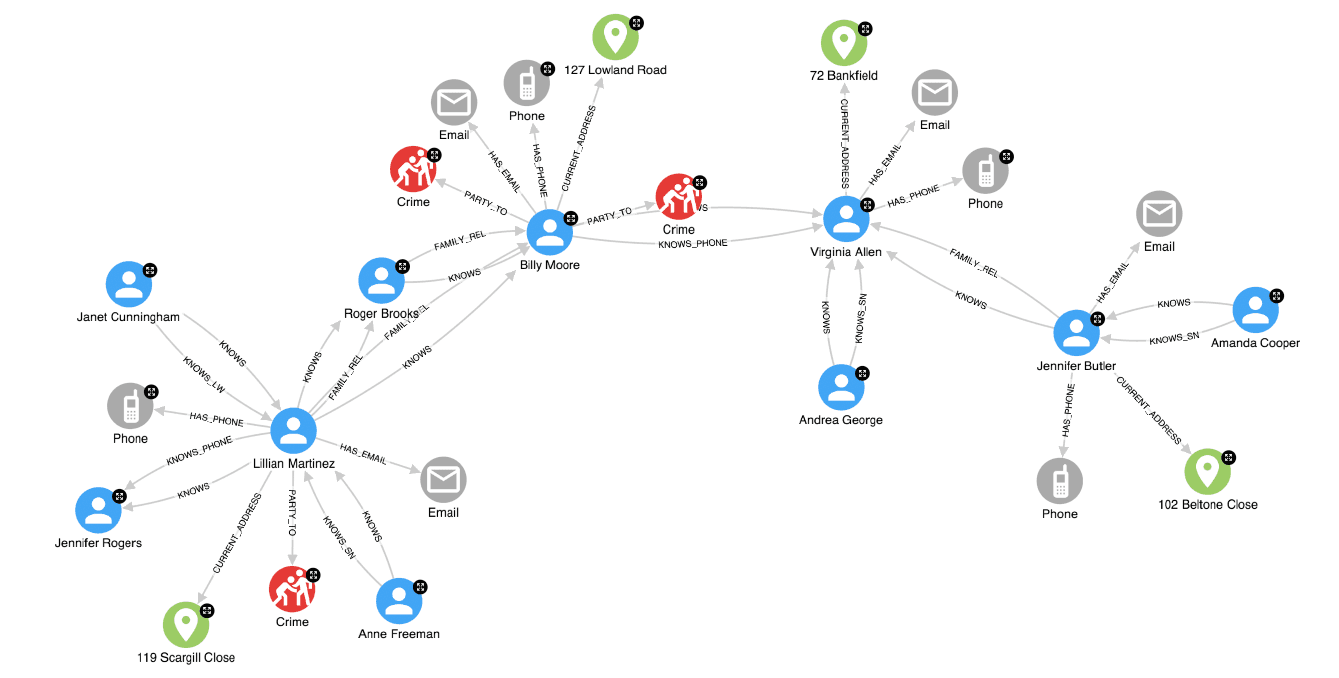Ranging across all the varied fields of intelligence, there is an ever-advancing process to enhance and optimise data analysis. For such mission-critical events, graph technology has emerged as an exceptional solution for all stages of the intelligence lifecycle, ensuring the absolute fastest and best results.
A graph analytics solution like Hume provides a simple-to-use interface that allows intelligence analysts to search, visualise and analyse intelligence graphs. The most common intelligence analysis questions are graph-based. For instance, “How are person X and person Y connected?” or “Who are the most influential individuals within a criminal organisation?”.
In this blog post, we will discuss the challenges that come with intelligence analysis, the limitation of existing relational-database tools and how graph-based solutions and Hume provide an answer.
What are the specific challenges facing intelligence teams?
- Siloed data: There is no central store of data that has been collected.
- Siloed analytical tooling: There is no single tool used by everyone for everything.
- Relational stores for network analysis: With relational stores, in-depth analysis is difficult.
- Ad-hoc data collection: Any given intelligence case may require new data to be loaded and analysed.
- Manual analysis: Throughout the entire process there are manual, time-consuming steps.
- Enormous data volumes and variety: The amount and variety of data make the intelligence process problematic.
Enabling graph technology in the intelligence process can transform the intelligence lifecycle and overcome the challenges facing analysts and stakeholders. Learn how numerous agencies have experienced the powerful benefits of utilizing graphs.
How Hume solves the challenges of the intelligence process
Siloed data
Analysts have to search through dozens of (relational) data stores to find the information they are looking for. An intelligence analyst might have to use 20 individual data sets and systems and all these data stores are disconnected. Consequently, intelligence analysts must devote significant amounts of time to finding connected information required for a particular case. A single view of intelligence
Hume solves this issue altogether. Intelligence data sources are ingested into Neo4j’s database and made available for analysis in Hume. It creates a single canvas of intelligence for the analysts, one source instead of having dozens of data sources.- Searchable: Hume automatically makes all ingested data full-text searchable, making it easy to find the right starting points for analysis.
- Connected: Mirroring the real world, all the data in Hume is connected. This enables the most granular, yet powerful kind of analysis – a step-by-step exploration of the network.

Siloed analytical tooling capabilities
In addition to siloed data, the capabilities needed for analysis are often conducted on multiple distinct platforms. This leads to fragmented analysis findings and makes collaboration burdensome. Many analysis capabilities
In Hume, you discover all the properties (e.g., ‘where’ and ‘when’) and relations of a crime on one single canvas and detect emerging trends within networks of interest. A sampling of Hume’s many features are:- Temporal Analysis: Hume helps you quickly analyse graph data that changes over time with a multi-value time bar and smart timezone support.
- Geospatial Analysis: Start your analysis by geofencing an area of interest or plot the results of your graph analysis on an interactive map.

Relational stores for network analysis
Intelligence analysts have been using tables to analyse criminal networks for decades. Some applications provide a graph visualisation that is built on relational tables in the backend. This allows analysts to view their data in a graph, but the data storage layer limits the depth and speed of analysis that can be completed.. Using tables, it is difficult to ask this system critical questions like “Who is the most important person in the network of interest?”, or “How are these two entities interconnected?”. Graph-based analysis with a graph data store
Utilising Neo4j, Hume can quickly and easily analyse criminal networks of interest. Neo4j is a graph-based native store for all the data sets needed. Hume provides a single system to analyse all those data and ask key questions.- Graph Native: Hume utilises Neo4j to provide a graph native analysis platform. Data sets are loaded and stored in a way that enables complex link analysis to be completed.
- Graph Data Science Ready: Hume puts Neo4j graph data science capabilities such as pathfinding, centrality, and community detection into the hands of intelligence analysts. With the click of a button, analysts can run these complex algorithms on their criminal networks of interest.

Ad-hoc data collection
Law enforcement intelligence is unique in that there is a significant amount of ad-hoc data collection. Analysts need tools that allow for the connection of newly ingested data with the relevant information currently available to them. Streamlined ad-hoc data ingestion
Hume includes simple-to-use tools to ingest ad-hoc datasets enabling analysts to add data to the graph, their single intelligence canvas.- Built-in Connectors: Hume ships with connectors to all mainstream data sources and first-class Neo4j read/write support.
- Sandpit Graphs: Hume allows for ad-hoc sandpit graphs to be created so that analysts can quickly and easily upload and analyse their files.
Manual analysis
All of these challenges ultimately mean that intelligence analysis has several manual steps. Analysts are often responsible for data cleaning, extraction, loading and the entire data analysis lifecycle. Use Actions to automate intelligence analysis
Hume has many features that help analysts optimise the intelligence process. The feature ‘Actions’ allow you to automate intelligence analysis. The devs team will configure a Cypher code snippet and make it available under a button for the analysts.- Flexible: Actions can return exportable tables, charts, as well as various graph formats, including a convenient preview of results.
- Powerful: Actions inherit the full power of Cypher and Neo4j GDS, plus much more. E.g., it’s easy to call an external API.

Enormous data volumes and variety
Law enforcement and intelligence agencies come into contact with enormous amounts of complex data types. It’s a significant challenge to extract the right amount of information from these sources. Extract insight from complex data types
Incorporate your data science outputs to supplement the single view of intelligence with entities and relationships extracted from complex data types. Hume will extract the key insights that you consider valuable and useful.- Photo and Video content: Hume enhances analysis outcomes by incorporating the outputs of your entity and relationship extraction tools and enabling graph analytics on their outputs. As shown below, Hume recognises two entities in two different pictures, indicating they are interconnected, and thus, a relationship is created on the canvas.
- Documents and NLP: Tap into the knowledge stored in documents by integrating with your existing tools that extract entities and relationships from text.

As graph experts, we can’t stress enough how transformational a graph analytics solution is for the intelligence process. Learn how our clients experience Hume and how it transformed a law enforcement agency’s intelligence process and the analysis process at a cybersecurity agency.
Would you like to know more about graphs in criminal intelligence? Or would you like to see a demonstration of the graph solution Hume? We showcased this, and more, in our Graphs in Criminal Intelligence webinar.








